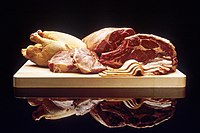
Photo from wikipedia
The primary objective of this study was to determine whether the level of concentrate allowance in an automated milking system (AMS) affects the feed intake, eating behavior, milking activity, and… Click to show full abstract
The primary objective of this study was to determine whether the level of concentrate allowance in an automated milking system (AMS) affects the feed intake, eating behavior, milking activity, and performance of lactating dairy cows. The secondary objective of this study was to describe how the response to concentrate allocation, specifically in feeding and milking behavior, varies with cow personality traits. Fifteen Holstein cows were used in a crossover design with two 28-d periods, each including 14 d of adaptation and 14 d of data collection. The cows were housed in a freestall pen with free-traffic access to the AMS. Treatments consisted of a basal partial mixed ration (PMR) common to both treatment groups, with a concentrate allowance (on dry matter basis) of (1) 3.0 kg/d in the AMS (L-AMS) or (2) 6.0 kg/d in the AMS (H-AMS). Between the 2 treatment periods, each cow was assessed for personality traits using a combined arena test consisting of exposure to a novel environment, novel object, and novel human. Principal component analysis of behaviors observed during the novel environment and object tests revealed 3 factors (interpreted as active, social, and alert-curious) that together explained 76% of the variance, whereas principal component analysis of the novel human test revealed 2 factors (interpreted as active-vocal and fearful of novel humans) that together explained 77% of the variance. When on the H-AMS treatment, PMR dry matter intake (DMI) was less (24.5 vs. 26.0 kg/d) and AMS concentrate delivery was greater (5.9 vs. 3.1 kg/d), as per design. Consequently, total DMI was greater on the H-AMS treatment (30.4 vs. 29.1 kg/d). When on the H-AMS treatment, cows who were more alert-curious consumed more PMR, whereas cows who were more fearful of the novel human were less likely to receive the maximum amount of AMS concentrate available, limiting their total DMI and increasing the day-to-day variability of that intake. Although this was a preliminary study, these data suggest an association between dairy cow personality traits and how cows respond to increased AMS concentrate allowance.
Journal Title: Journal of dairy science
Year Published: 2022
Link to full text (if available)
Share on Social Media: Sign Up to like & get
recommendations!